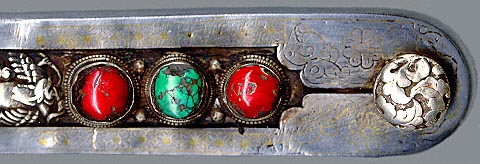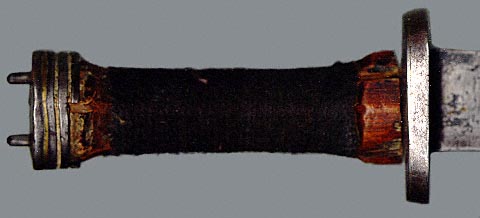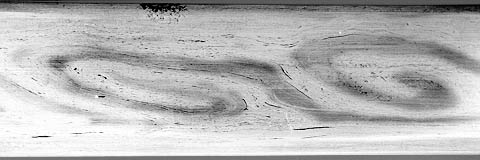 |
 |
 |

|
|
|
 |
 |
 |

|
|
|
These swords were usually worn, edge up, diagonally on the front of the body, with the hilt located so that the right hand might rest upon it, the scabbard inserted into (and likely tightly tied by) the long wool fabric waist belt worn with traditional costume. Belt attachments are seldom seen on scabbards. A photograph of a Tibetan prince wearing a sword in this manner appeared in the National Geographic in 1925 and was reprinted in Bryan (1987), p.189. The Khampas (tribesmen of Eastern Tibet) will sometimes carry a longsword such as that shown in example 1 or 2, a cubit (tip of middle finger to elbow) length short sword, and a utility or "meat knife".
Example 2. Another Tibetan sword likely dating from the late 19th to early 20th Century. The hilt is composed of an engraved iron pommel, ferrule and guard each showing remaining traces of gilding. A wooden grip of sharp rectangular cross-section lies between the pommel and ferrule. A coral likely was once present on the display face of the pommel, but is now lost. The guard is hollow facing the blade as is that on example 3 below. The single-edged blade is reversed in edge orientation relating to the display face of the mounts when compared with the other examples. The blade is forged and of piled construction. In this example, the contrasting bands join near the tip and, unusually, also join nearing the guard as well (photograph above). In cross-section, the blade is basically triangular, though the faces flatten and round back slightly towards the spine. The scabbard consists of a wood lining encased in metal. The frame or outline of the scabbard is made out of a single strip of iron which partially wraps over the faces on either side in a "U" fashion. Towards the tip of the scabbard, the display face is engraved and gilded and a raised white metal (likely silver) knob is attached. The display face of the scabbard is set with two corals and a turquoise in bezels mounted on a gilded, engraved and pierced iron plate. Elsewhere, on both sides of the scabbard the faces are covered with fabric showing a leopard-like print. Overall length (including scabbard): 78.7 cm. (30.8 inches); blade length: 59 cm. (23.2 inches). Richardson (1989, p. 184) regards the straight, though single-edged, blades having a short angled tip to be archaic survivals following centuries-old tradition and distinguishes between "ornate" and "plain" types, the latter being traditionally, though uncertainly, associated with Bhutan. Jones (1996, p. 173) distinguishes between blades with long, sharp points and blades with a short oblique point, and reports an average blade length of 63.5 cm.
 |
 |
 |
|
|
Tibetan swords characteristically have blades of piled construction, with several bands evident located particularly within the two-thirds to one-half of blade width nearest to the spine. Visible owing to differential patination of differing materials, these bands generally run parallel to the length of the blade, usually with gentle undulations, such as are seen above in the blade detail photographs of examples 2 and 3. Pairs of bands generally converge approaching the tip (see upper left photo, below), testifying to a structure made by "side-by-side welding of a nested series of hairpin rods" as phrased and postulated by Smith (1960, p. 8 - 9). Tibetan swords with coarse twisted piled structures are also known and on display in museums such as the Royal Armouries in Leeds, England. The sword-daos of the Naga in adjoining Assam show similar piled construction techniques in their blades.
1 2 2  |
 |
 |
|
3, 4. Photographs of a Tibetan sword blade showing multiple repeated twisting "jelly-roll" patterns (Photographs 3 & 4 are courtesy of Artzi Yarom of Oriental Arms.) |
Many thanks to the Venerable Lama Rinchen Phuntsok, Alan Suits of Coyote's Paw Gallery, Artzi Yarom of Oriental Arms, Sonam Atuk, Philip Tom and Jim McDougall for their assistance in the preparation of this article. Additional examples
A definitive (and beautifully produced) book on Tibetan arms
and armour was published in 2006 in conjunction with an exhibition
at the Metropolitan Museum of Art in New York. This work will
likely remain the standard for a very long time and remains available
at a very reasonable price and is most strongly recommended to
anyone with an interest in this subject:
LaRocca, Donald J., et. al., Warriors of the Himalayas:
Rediscovering the Arms and Armor of Tibet (New York: Metropolitan
Museum of Art, 2006).
Bryan. C. D. B., The National Geographic Society: 100 Years of Adventure and Discovery (New York: Harry N. Abrams, Inc., 1987).
Jones, Schuyler, Tibetan Nomads: Environment, Pastoral Economy, and Material Culture (New York: Thames and Hudson, 1996), p. 173 - 175, 194, 212 - 213. Descriptions of swords in the National Museum of Denmark are included, but there are no illustrations of swords.
Norbu, Thubten Jigme and Turnbull, Colin M., Tibet (New York: Simon & Schuster, 1968). The Tibetan sword is referred to as tri. Page 102 includes several small line drawings of swords , numbers 4 through 8, with 6 through 8 apparently detailing types of blade patterns: Dmar Gyi Gya Mtsho Phug Pa appears to refer to the "jelly roll" damascus pattern seen above and Hgu Zi appears to refer to the "nested hairpin" pattern-welded structure.
Richardson, Thom, "China and Central Asia," in Swords and Hilt Weapons (New York: Weidenfeld and Nicolson, 1989), p. 184 -185. A few examples are pictured and briefly described.
Richardson, Thom, "The Ming Sword," in Royal Armouries Yearbook 1 (1996), p. 95 - 99. A Chinese jian attributed to the early 15th Century (Ming dynasty) and presumed made for presentation to a Tibetan monastery is illustrated and described. The blade, not illustrated, is described as being straight, double-edged and 76 cm. in length, having a diamond shaped cross-section and pattern-welded composition.
Smith, Cyril Stanley, A History of Metallography: The Development of Ideas on the Structure of Metals Before 1890 (Chicago: The University of Chicago Press, 1960) p. xxii, 8 - 9. (A second impression with additions, dated 1965, was also published.) The laminated blades are briefly described and illustrated.